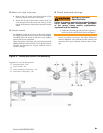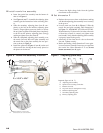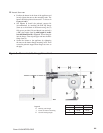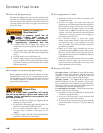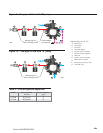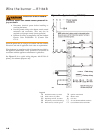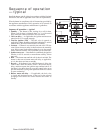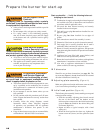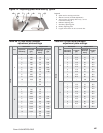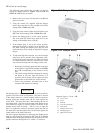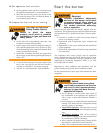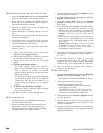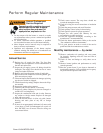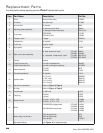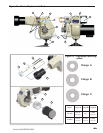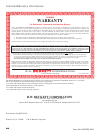20
Form 6104 BCF23-R05
Start burner and vent air from oil line
Move the low-fi re hold switch to the low fi re hold
position (to hold burner in low fi re when started).
Verify that the air adjusting cam (Figure 13b, item
d) has been set to the initial low-fi re air setting as
described under Initial air settings.
Open the oil shutoff valves in the oil supply (and
return) line(s) to the burner.
Set the thermostat (or operating control) to call for
heat.
Close the line switch to the burner. The burner motor
should start immediately.
If the burner motor does not start, reset the motor
overload switch (if so equipped) and press the reset
switch of the burner primary control.
Vent the fuel unit as soon as the burner motor starts
rotating. To vent —
Attach a clear plastic tube to the air bleed valve
(Figure 9 or 10 as applies, item p).
Place the end of the tube in a container to catch the
oil. Then loosen the fuel unit air vent valve.
Tighten the air vent valve after all air has been
purged.
IF burner stops during venting —
The burner primary control will lockout if
fl ame is not established within its time limit.
This is typically 15 seconds for R7184B
primary controls, but may be less for other fl ame
supervisory controls.
The burner may lockout several times during the
period needed to purge all the air. To extend air
venting time, press the red reset button for 1/2
second during the prepurge cycle to continue
purging.
IF burner stops after fl ame established —
Additional venting is probably required. Repeat
the air venting procedure.
Once fl ame is steady, proceed to Set high-fi re air.
Set high-fi re air
Allow the burner to run at low fi re until the appli-
ance has warmed suffi ciently.
Visually check the fl ame. The fl ame should not be
dark orange or smoky. If the fl ame appears to be
smoking, increase the amount of air by readjusting
the damper indicator to a higher number.
1.
2.
3.
4.
5.
6.
7.
y
y
y
y
-
-
y
-
8.
1.
2.
Once the appliance has warmed, the high-fi re setting
can be checked and adjusted.
Locate the approximate air adjusting plate setting for
high fi re in Table 4a or 4b.
Place the low-fi re hold switch in the high-fi re
position. The damper motor will begin to rotate after
four seconds.
6. Use combustion test instruments to adjust the burner.
a. Adjust the air by moving the red cam to a lower
number until a trace of smoke is achieved with
CO
2
level as high as possible (lowest possible O
2
).
Example: 13.5% CO
2
(2.5% O
2
) with a trace of
smoke.
b. Increase the air by increasing the red cam number to
reduce CO
2
by 2 percentage points at a zero smoke
level. (Increase O
2
by 3 percentage points at a zero
smoke level.)
Example: Reduce CO
2
from 13.5% to 11.5%, with
zero smoke (or increase O
2
from 2.5% to 5.5%).
c. A margin of reserve air has been added to
accommodate variable conditions.
Check the breech draft pressure against the appliance
manufacturer’s recommended setting (typically +
0.1” W.C.).
If the breech pressure is higher or lower than
recommended level, adjust the appliance breech
damper to achieve the specifi ed setting. Recheck the
smoke and CO
2
levels. Adjust burner air if necessary.
Once all settings are complete and satisfactory,
proceed to ‘Set low-fi re air’.
Set low-fi re air
Move the low-fi re hold switch from the “High Fire
position” to the “Low Fire Hold” position.
a. The damper will return to the low-fi re air setting.
Check the smoke and CO
2
(O
2
) levels.
a. Pull a smoke sample from the fl ue.
b. The sample should be clean (zero smoke level).
c. Check the CO
2
(O
2
) level:
CO
2
should be at 11 to 12% (O
2
at 5.9 to 4.5%).
If the CO
2
is less than 11% (O
2
more than 5.9%),
decrease the air and check the smoke level.
Operate the burner from low fi re to high fi re and back
to verify operation.
Turn the burner off. Wait one or two minutes (for
chamber to clear) and then turn on again to verify
starting characteristics.
Perform limit circuit performance test specifi ed by
appliance manufacturer to verify operation of burner/
appliance combination.
3.
4.
5.
7.
8.
9.
1.
2.
3.
4.
5.



